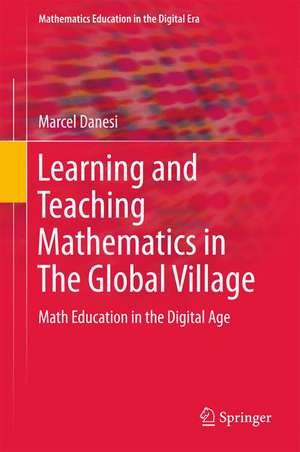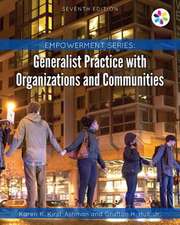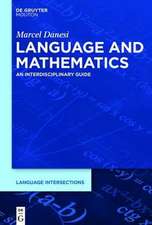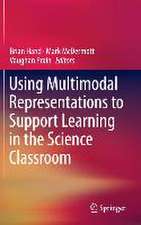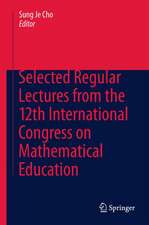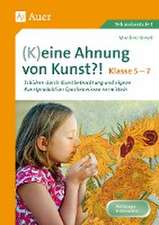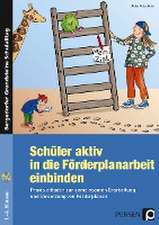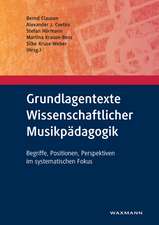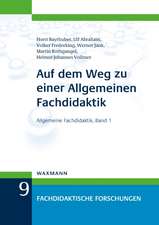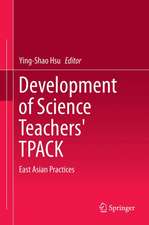Learning and Teaching Mathematics in The Global Village: Math Education in the Digital Age: Mathematics Education in the Digital Era, cartea 6
Autor Marcel Danesien Limba Engleză Hardback – 9 mai 2016
| Toate formatele și edițiile | Preț | Express |
|---|---|---|
| Paperback (1) | 382.57 lei 6-8 săpt. | |
| Springer International Publishing – 27 mai 2018 | 382.57 lei 6-8 săpt. | |
| Hardback (1) | 389.88 lei 6-8 săpt. | |
| Springer International Publishing – 9 mai 2016 | 389.88 lei 6-8 săpt. |
Din seria Mathematics Education in the Digital Era
- 15%
 Preț: 642.68 lei
Preț: 642.68 lei - 24%
 Preț: 739.44 lei
Preț: 739.44 lei - 18%
 Preț: 782.42 lei
Preț: 782.42 lei - 15%
 Preț: 644.82 lei
Preț: 644.82 lei - 18%
 Preț: 1127.15 lei
Preț: 1127.15 lei - 18%
 Preț: 959.36 lei
Preț: 959.36 lei - 18%
 Preț: 952.26 lei
Preț: 952.26 lei - 24%
 Preț: 804.93 lei
Preț: 804.93 lei - 18%
 Preț: 990.93 lei
Preț: 990.93 lei -
 Preț: 438.10 lei
Preț: 438.10 lei - 18%
 Preț: 953.03 lei
Preț: 953.03 lei - 18%
 Preț: 889.92 lei
Preț: 889.92 lei - 24%
 Preț: 875.83 lei
Preț: 875.83 lei - 24%
 Preț: 752.35 lei
Preț: 752.35 lei -
 Preț: 360.15 lei
Preț: 360.15 lei - 15%
 Preț: 649.06 lei
Preț: 649.06 lei - 20%
 Preț: 573.77 lei
Preț: 573.77 lei -
 Preț: 394.29 lei
Preț: 394.29 lei - 15%
 Preț: 649.54 lei
Preț: 649.54 lei - 18%
 Preț: 1117.50 lei
Preț: 1117.50 lei - 18%
 Preț: 1112.78 lei
Preț: 1112.78 lei
Preț: 389.88 lei
Nou
Puncte Express: 585
Preț estimativ în valută:
74.61€ • 77.61$ • 61.60£
74.61€ • 77.61$ • 61.60£
Carte tipărită la comandă
Livrare economică 14-28 aprilie
Preluare comenzi: 021 569.72.76
Specificații
ISBN-13: 9783319322780
ISBN-10: 3319322788
Pagini: 177
Ilustrații: XI, 185 p. 26 illus.
Dimensiuni: 155 x 235 x 13 mm
Greutate: 0.46 kg
Ediția:1st ed. 2016
Editura: Springer International Publishing
Colecția Springer
Seria Mathematics Education in the Digital Era
Locul publicării:Cham, Switzerland
ISBN-10: 3319322788
Pagini: 177
Ilustrații: XI, 185 p. 26 illus.
Dimensiuni: 155 x 235 x 13 mm
Greutate: 0.46 kg
Ediția:1st ed. 2016
Editura: Springer International Publishing
Colecția Springer
Seria Mathematics Education in the Digital Era
Locul publicării:Cham, Switzerland
Cuprins
Preface.- 1. An Overview of the History of Mathematics Pedagogy.-1.1 Mathematics in Antiquity.-1.2 Mathematics in the Medieval and Renaissance Periods.- 1.3 Mathematics in the Enlightenment and Romantic Periods.- 1.4 Mathematics in the Modern Era.- 1.5 Mathematics in the Digital Era.- 2. New Technologies in the Teaching of Teaching and Learning of Mathematics.- 2.1 Research on the Use of Video Games.- 2.2 Research on the Use of YouTube.- 2.3 Research on the Formation of Math Communities on Facebook and Twitter.- 2.4 Classroom Applications and Implications.- 2.5 Pedagogical Theories and Their Validity in the Internet Age.- 3. Interconnectedness in Mathematics Education.- 3.1 The Concepts of Interconnectedness and Network Competence.- 3.2 Connecting Mathematics to the Global Village.- 3.3 Mathematics in the Media.- 3.4 Using Puzzle Sites to Create a Pedagogical Forum.- 3.5 Creating Mathematical Themes Relevant to Interconnectedness.- 4. Interactivity and Multimodality in Mathematics Education.- 4.1 The Notion of Interactivity.- 4.2 The Notion of Multimodality.- 4.3 Relevant Educational Research.- 4.4 The Interactive Classroom.- 4.5 Some Experimental Proposals.- 5. Blending in Mathematics Education.- 5.1 The Notion of Blending.- 5.2 The Work of Lakoff, Turner, and Others.- 5.3 Conceptual Fluency in Math Education.- 5.4 The Internet as a Source of “Cyber-Blending”.- 5.5 Concluding Remarks.
Recenzii
“This book is one of the very best to address what teaching and learning mathematics should be in the age of connected technology. … The book is highly recommended for an undergraduate course in methods of teaching mathematics. … Also, it is a wonderful text for a professional development course for math teachers whose education preceded the widespread use of technology tools for the classroom.” (G. Abramson, Computing Reviews, computingreviews.com, October, 2016)
“There is no question that the modern educator must use the technology that has created the global village: the students demand it. … Danesi does an excellent job in describing many aspects of the changes taking place in mathematics education. … If you are looking for ways to introduce a little edutainment into your classes, this book will get you started with both information and directions to follow.” (Charles Ashbacher, MAA Reviews, maa.org, August, 2016)
“There is no question that the modern educator must use the technology that has created the global village: the students demand it. … Danesi does an excellent job in describing many aspects of the changes taking place in mathematics education. … If you are looking for ways to introduce a little edutainment into your classes, this book will get you started with both information and directions to follow.” (Charles Ashbacher, MAA Reviews, maa.org, August, 2016)
Textul de pe ultima copertă
This book provides a fundamental reassessment of mathematics education in the digital era. It constitutes a new mindset of how information and knowledge are processed by introducing new interconnective and interactive pedagogical approaches. Math education is catching up on technology, as courses and materials use digital sources and resources more and more. The time has come to evaluate this new dynamic, which transcends all previous use of ancillary devices to supplement classroom math instruction. Interactivity and interconnectivity with the online world of math and math texts (such as television programs and internet sites) can be integrated with our traditional modes for delivery of math instruction.
This book looks at how this integration can unfold practically by applying these relevant pedagogical principles to elementary topics such as numeration, arithmetic, algebra, story problems, combinatorics, and basic probability theory. The book further exemplifies how mathematics can be connected to topics in popular culture, information technologies, and other such domains.
This book looks at how this integration can unfold practically by applying these relevant pedagogical principles to elementary topics such as numeration, arithmetic, algebra, story problems, combinatorics, and basic probability theory. The book further exemplifies how mathematics can be connected to topics in popular culture, information technologies, and other such domains.
Caracteristici
Provides a fundamental reassessment for math education in the digital era Introduces a new approach for introducing technology into the math classroom Provides state-of-the art literature review of digital math pedagogy Examines the nature of mathematical learning as part of other learning modes Includes supplementary material: sn.pub/extras
